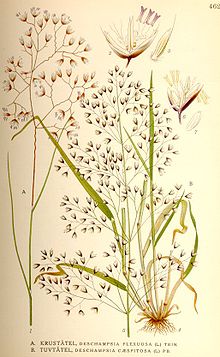Vahlodea
| Deschampsia | |
|---|---|
 |
|
|
Deschampsia flexuosa (left) Deschampsia cespitosa (right) |
|
| Scientific classification | |
| Kingdom: | Plantae |
| (unranked): | Angiosperms |
| (unranked): | Monocots |
| (unranked): | Commelinids |
| Order: | Poales |
| Family: | Poaceae |
| Subfamily: | Pooideae |
| Tribe: | Poeae |
| Subtribe: | Airinae |
| Genus: |
Deschampsia P.Beauv. |
| Type species | |
|
Deschampsia cespitosa (L.) P.Beauv. |
|
| Synonyms | |
|
|
Deschampsia is a genus of plants in the grass family, commonly known as hair grass or tussock grass. The genus is widespread across many countries.
The genus is named for French physician and naturalist Louis Auguste Deschamps (1765-1842).
Deschampsia species are used as food plants by the larvae of some Lepidoptera species including antler moth, the clay, clouded-bordered brindle, common wainscot, dark arches, dusky brocade, shoulder-striped wainscot, smoky wainscot and wall.
Deschampsia sometimes grow in boggy acidic formations, an example of which is the Portlethen Moss, Scotland. Deschampsia antarctica is the world's most southern monocot, and one of only two flowering plants of Antarctica.
Numerous species now regarded a better suited to other genera:Aira, Antinoria, Bromus, Calamagrostis, Centropodia, Colpodium, Dissanthelium, Holcus, Periballia, Peyritschia, Poa, Trisetum and Vahlodea.
...
Wikipedia
